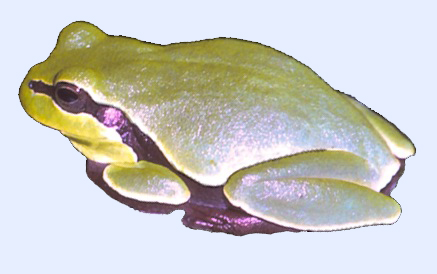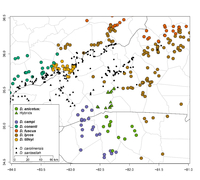Taxonomy
Class: AmphibiaOrder: CaudataFamily: PlethodontidaeSubfamily: PlethodontinaeAuthor: Pyron and Beamer, 2023
Taxonomic Comments: The Spotted Dusky Salamander (Desmognathus conanti ) and Northern Dusky Salamander (D. fuscus ) as traditionally recognized by herpetologists have a long and complex taxonomic history, with the former originally described as a subspecies of D. fuscus . It was treated as such until genetic studies revealed that it is not closely related to the latter (Beamer and Lamb 2008; Kozak et al. 2005). According to the latest systematic treatment of these species by Pyron and Beamer (2023a) At least 10 other currently recognized species of Desmognathus were either described from populations previously considered to be D. fuscus , described as or later considered to be subspecies of D. fuscus , or later considered to be synonyms of D. fuscus before ultimately being recognized as distinct species. The latest molecular analyses have also revealed extensive cryptic diversity within both D. conanti and D. fuscus as currently conceived, with these two species constituting a polyphyletic assemblages of 13 distinct mitochondrial lineages and perhaps as many as 11 candidate species. Pyron and Beamer (2023a) provide a very comprehensive review of the taxonomic history of this group. Desmognathus species and lineages. Gene exchange has occurred between both phylogenetically sister and geographically adjacent populations, as well as between distantly related and spatially separated groups. In summary, both D. conanti and D. fuscus are now each known to represent polyphyletic assemblages of multiple, geographically well-defined candidate species that are phylogenetically interdigitated with other recognized species. The candidate species include a “mountain dusky”phenotype with smaller, gracile bodies and round tails, a lowland “dusky” type with more robust, larger bodies and keeled tails, and a smaller lowland “dusky” form often associated with ravine streams and adjacent swamps, with slenderer bodies and less heavily-keeled tails.D. conanti and D. fuscus, the authors recognized six additional species based on genetic, geographic, and morphological evidence. They also redefined D. conanti and D. fuscus . The new species are D. anicetus , D. bairdi , D. campi , D. catahoula , D. lycos and D. tilleyi . Among the newly described species, all but D. catahoula occur in North Carolina. D. anicetus is apparently involved in either historic or present day gene flow with adjacent species including Desmognathus campi , D. carolinensis , and potentially D. tilleyi historically (Tilley and Mahoney 1996; Beamer and Lamb 2020; Pyron et al. 2022). Mitochondrial haplotypes from D. campi and D. carolinensis are found in populations in the Saluda Mountains of North Carolina and extending to Hickory Nut Gorge (see range map above). these populations exhibit hybrid ancestry from those species and D. tilleyi based on limited sampling of phylogenomic loci. Phylogenetic network analyses also implicate D. anicetus in the reticulation between D. carolinensis and D. lycos (Pyron et al. 2020). Additional geographic and genetic sampling will be needed to understand the complex history of gene flow between Desmognathus species in this region.Species Comments:
Identification
Description: Pyron and Beamer (2023a) characterized this newly described species as being a smaller, more slender, and more gracile species than the other species that were split off from D. fuscus , with the SVL ranging from 17–51 mm for metamorphosed individuals. The tail is rounded, long, and gradually tapered much like a mountain dusky salamander. The adults typically have a bold dorsal color-pattern that consists of 6–8 pairs of often diamond-shaped dorsal blotches that develop from larval spots, with five or six pairs between the limbs. These can be reddish, orangish, or yellowish and are sometimes fused into a continuous dorsal stripe with irregular borders. The dorsal ground color tends to be dark brown to blackish, which often creates a strong contrast between the blotches and the background. In many adults, the lateral surfaces exhibit a frosted or lichenous wash that is interspersed with dark flecking. This generates a distinct or abrupt transition to the darker dorsal coloration along the dorsolateral margin, often yielding a noticeable “two-tone” effect. This lateral coloration often extends from the venter, which frequently exhibits a similar patchy flecking of clumped dark brown and lighter marks.Online Photos: Google iNaturalist Observation Methods: The adults can be found by searching cover objects in streams and streamside habitats. AmphibiaWeb Account
Distribution in North Carolina
Distribution Comments: Pyron and Beamer (2023a) noted that genetically cohesive populations of D. anicetus are found primarily in South Carolina and the adjacent Blue Ridge foothills in Greenville and Spartanburg counties, and potentially into nearby North Carolina. Populations extending from the Saluda Mountains of adjacent North Carolina northward towards Hickory Nut Gorge are apparently of hybrid origin, sharing genomic ancestry and mitochondrial haplotypes with both D. campi and D. carolinensis , while still exhibiting some phenotypic similarity and phylogenetic proximity to pure D. anicetus (see distribution map above). Here, we treat these as D. anicetus . As currently known, populations in North Carolina comprise a southern group in southern Henderson and western Polk County, along with an apparently disjunct northern group in northeastern Henderson, southeastern Buncombe, and perhaps extreme northwestern Rutherford County (Pyron and Beamer, 2023a)Distribution Reference: Pyron and Beamer (2023a)County Map: Clicking on a county returns the records for the species in that county.
GBIF Global Distribution
Key Habitat Requirements
Habitat: Like many of our smaller Desmognathus species, D. anicetus is associated with headwater and lower-order streams that flow through forested coves and ravines. These habitats either lack or have low densities of predatory fishes relative to more downstream areas.Biotic Relationships: Almost all aspects of the life history of this newly described species are undocumented.
Life History and Autecology
Breeding and Courtship: The courtship behavior is undocumented.
General Ecology
Adverse Environmental Impacts
Status in North Carolina
NHP State Rank: [S2S3]Global Rank: GNRStatus in North Carolina: [W]Status Comments: This species reaches the northern limit of its range just across the North Carolina border in southern Henderson and western Polk counties northward towards Hickory Nut Gorge. Populations in North Carolina appear to be of hybrid origin, sharing genomic ancestry with both D. campi and D. carolinensis , while still exhibiting some phenotypic similarity and phylogenetic proximity to pure D. anicetus . Populations in North Carolina constitute a separate sublineage and need additional surveys to determine their distribution and genetic composition.

 »
»

 »
»